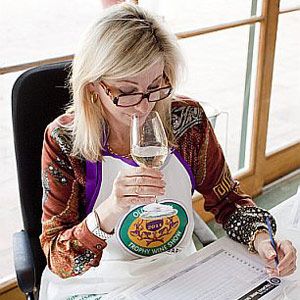There are a lot of wine shows and competitions in South Africa – Veritas, Michaelangelo, Juliet Cullinan, Top 100 SA Wines, Young Wines, Terroir, Diners Club – the list goes on and on. But for the last ten years, one show stands out as being the most rigorous and the stingiest (in terms of medals awarded) – the Old Mutual Trophy Wine Show. Previously known as the Fairbairn Capital, it has created a fearsome reputation for quality and the highest standards in the country, so when I was asked to help compile the awards book, Icons, I jumped at the chance to see how it operated firsthand. The fact that I got to spend a week in the five star luxury of the Grande Roche was, of course, neither here nor there.
The first thing which struck me about the whole event is how much hard work it all is. My day started at 7am as I and the auditor checked wines against lists adding in ‘barrel-fermented’ or ‘single vineyard’, correcting ‘Muscadel’ to ‘Muskadel’, verifying vintages and confirming varieties. But our early start was beaten by the backroom team (the ‘Grande Cru’)of Wine Magazine’s Celia Gilloway, who were laying out glasses and opening bottles at least an hour before we arrived. The judges managed to saunter in at a comparatively civilised 8am – and immediately began tasting ten minutes later (at which point my envy at their lie-in evaporated) and so the days continued until 8.30pm and sometimes even later as the arguments raged over whether a wine was silver or gold.
Spending time over the four days with all the judges was definitely the most eye-opening part of the experience. When one looks at the results of competitions, it is very easy to criticise strange decisions, omissions and seemingly random inclusions. What you don’t realise is how passionately these judges care about the choices they make. They discussed the wines endlessly – over lunch, at dinner, after dinner and then again at breakfast – constantly debating whether a wine was worthy or not, always aware that a difference of only one point can have a massive effect on a winery, particularly in these fraught economic times.
Their memories for wines were impressive, their desire to find consensus was gently persistent (despite several cultural differences between judges) and their stamina was awe-inspiring. On day one, I and other members of the back room team held the fort with hungry sponsors for almost two hours as dinner was delayed again and again until agreement could be reached on the last wines. And then they left the tasting room and came straight to dinner to fulfil their other obligations of circulating, pressing-the-flesh and chatting up the great and good of Old Mutual. Not an easy job at all.
Other things that struck me over the course of the week:
• The amount of effort which goes into ensuring that all the wines truly are tasted blind – each bottle is numbered as are the glasses. All the wines are poured without the judges being present, so they can’t even make any guesses from the shape or colour of the bottle as to the contents.
• The professional rigour with which the tasting is audited. Charnez Jacobs from accountancy firm PKF was present when every wine was poured, including all re-pours throughout the day and all the top wines are submitted to an independent laboratory to confirm the show sample is identical to the wine available on the shelf.
• The huge waste of all the leftover wine which was all poured down the increasingly-smelly and fruit fly-infested drain. Celia had made valiant efforts to find a company which would recycle it without success. Any ideas for next year, gratefully received (I did my best to drink as much as I could, but 1,062 bottles was a big ask even for me!).
• The growing use of social media in the wine sector. I was tweeting on behalf of Wine Magazine and it was fantastic to see questions flooding in for the international judges, suggestions of places they could visit, queries about how best to approach foreign markets etc etc. The feedback session was marginally better attended than previous years and blogposts and tweets have already created a high level of interest in the results which will be published on the 1st June. In the words of @TVDionysus ‘Keep up all the tweets & posts, really enjoying it. Feel part of process. Cheers!’
The winning wines will be announced on 1st June and the top wines can then be tasted in Cape Town on 9th June and in Johannesburg 10th June. Tickets are available from Computicket.

